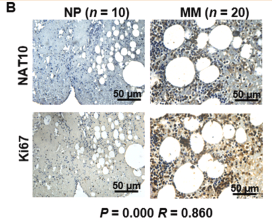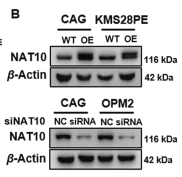NAT10 Antibody - #DF12427
| Product: | NAT10 Antibody |
| Catalog: | DF12427 |
| Description: | Rabbit polyclonal antibody to NAT10 |
| Application: | WB IHC |
| Cited expt.: | WB, IHC |
| Reactivity: | Human, Mouse, Rat |
| Prediction: | Pig, Zebrafish, Bovine, Horse, Sheep, Rabbit, Dog, Chicken, Xenopus |
| Mol.Wt.: | 116 kDa; 116kD(Calculated). |
| Uniprot: | Q9H0A0 |
| RRID: | AB_2845232 |
Related Downloads
Protocols
Product Info
*The optimal dilutions should be determined by the end user. For optimal experimental results, antibody reuse is not recommended.
*Tips:
WB: For western blot detection of denatured protein samples. IHC: For immunohistochemical detection of paraffin sections (IHC-p) or frozen sections (IHC-f) of tissue samples. IF/ICC: For immunofluorescence detection of cell samples. ELISA(peptide): For ELISA detection of antigenic peptide.
Cite Format: Affinity Biosciences Cat# DF12427, RRID:AB_2845232.
Fold/Unfold
ALP; DKFZp434C116; FLJ10774; FLJ12179; FLJ23850; hALP; KIAA1709; N acetyltransferase 10; N acetyltransferase 10 GCN5 related; N acetyltransferase like; N acetyltransferase like protein; N-acetyltransferase 10; NAT10; NAT10_HUMAN; NET43;
Immunogens
A synthesized peptide derived from human NAT10, corresponding to a region within the internal amino acids.
- Q9H0A0 NAT10_HUMAN:
- Protein BLAST With
- NCBI/
- ExPASy/
- Uniprot
MHRKKVDNRIRILIENGVAERQRSLFVVVGDRGKDQVVILHHMLSKATVKARPSVLWCYKKELGFSSHRKKRMRQLQKKIKNGTLNIKQDDPFELFIAATNIRYCYYNETHKILGNTFGMCVLQDFEALTPNLLARTVETVEGGGLVVILLRTMNSLKQLYTVTMDVHSRYRTEAHQDVVGRFNERFILSLASCKKCLVIDDQLNILPISSHVATMEALPPQTPDESLGPSDLELRELKESLQDTQPVGVLVDCCKTLDQAKAVLKFIEGISEKTLRSTVALTAARGRGKSAALGLAIAGAVAFGYSNIFVTSPSPDNLHTLFEFVFKGFDALQYQEHLDYEIIQSLNPEFNKAVIRVNVFREHRQTIQYIHPADAVKLGQAELVVIDEAAAIPLPLVKSLLGPYLVFMASTINGYEGTGRSLSLKLIQQLRQQSAQSQVSTTAENKTTTTARLASARTLYEVSLQESIRYAPGDAVEKWLNDLLCLDCLNITRIVSGCPLPEACELYYVNRDTLFCYHKASEVFLQRLMALYVASHYKNSPNDLQMLSDAPAHHLFCLLPPVPPTQNALPEVLAVIQVCLEGEISRQSILNSLSRGKKASGDLIPWTVSEQFQDPDFGGLSGGRVVRIAVHPDYQGMGYGSRALQLLQMYYEGRFPCLEEKVLETPQEIHTVSSEAVSLLEEVITPRKDLPPLLLKLNERPAERLDYLGVSYGLTPRLLKFWKRAGFVPVYLRQTPNDLTGEHSCIMLKTLTDEDEADQGGWLAAFWKDFRRRFLALLSYQFSTFSPSLALNIIQNRNMGKPAQPALSREELEALFLPYDLKRLEMYSRNMVDYHLIMDMIPAISRIYFLNQLGDLALSAAQSALLLGIGLQHKSVDQLEKEIELPSGQLMGLFNRIIRKVVKLFNEVQEKAIEEQMVAAKDVVMEPTMKTLSDDLDEAAKEFQEKHKKEVGKLKSMDLSEYIIRGDDEEWNEVLNKAGPNASIISLKSDKKRKLEAKQEPKQSKKLKNRETKNKKDMKLKRKK
Predictions
Score>80(red) has high confidence and is suggested to be used for WB detection. *The prediction model is mainly based on the alignment of immunogen sequences, the results are for reference only, not as the basis of quality assurance.
High(score>80) Medium(80>score>50) Low(score<50) No confidence
Research Backgrounds
RNA cytidine acetyltransferase that catalyzes the formation of N(4)-acetylcytidine (ac4C) modification on mRNAs, 18S rRNA and tRNAs. Catalyzes ac4C modification of a broad range of mRNAs, enhancing mRNA stability and translation. mRNA ac4C modification is frequently present within wobble cytidine sites and promotes translation efficiency. Mediates the formation of ac4C at position 1842 in 18S rRNA. May also catalyze the formation of ac4C at position 1337 in 18S rRNA (By similarity). Required for early nucleolar cleavages of precursor rRNA at sites A0, A1 and A2 during 18S rRNA synthesis. Catalyzes the formation of ac4C in serine and leucine tRNAs (By similarity). Requires the tRNA-binding adapter protein THUMPD1 for full tRNA acetyltransferase activity but not for 18S rRNA acetylation. In addition to RNA acetyltransferase activity, also able to acetylate lysine residues of proteins, such as histones, microtubules, p53/TP53 and MDM2, in vitro. The relevance of the protein lysine acetyltransferase activity is however unsure in vivo. Activates telomerase activity by stimulating the transcription of TERT, and may also regulate telomerase function by affecting the balance of telomerase subunit assembly, disassembly, and localization.
Acetylation at Lys-426 is required to activation of rRNA transcription. May be autoacetylated; however ability to autoacetylate in vivo requires additional evidences.
Nucleus>Nucleolus. Midbody.
Note: Nucleolar in interphase and redistributes to the perichromosomal layer and to the midbody during telophase.
Belongs to the RNA cytidine acetyltransferase family. NAT10 subfamily.
Research Fields
· Genetic Information Processing > Translation > Ribosome biogenesis in eukaryotes.
References
Application: IHC Species: Human Sample:
Application: WB Species: Human Sample:
Restrictive clause
Affinity Biosciences tests all products strictly. Citations are provided as a resource for additional applications that have not been validated by Affinity Biosciences. Please choose the appropriate format for each application and consult Materials and Methods sections for additional details about the use of any product in these publications.
For Research Use Only.
Not for use in diagnostic or therapeutic procedures. Not for resale. Not for distribution without written consent. Affinity Biosciences will not be held responsible for patent infringement or other violations that may occur with the use of our products. Affinity Biosciences, Affinity Biosciences Logo and all other trademarks are the property of Affinity Biosciences LTD.



